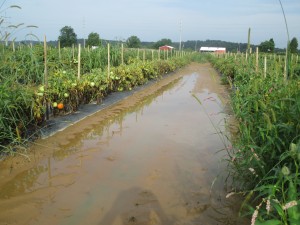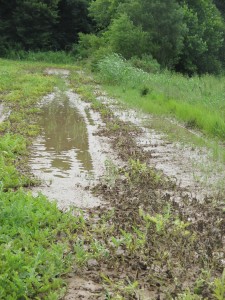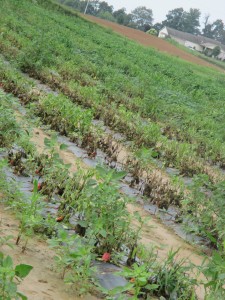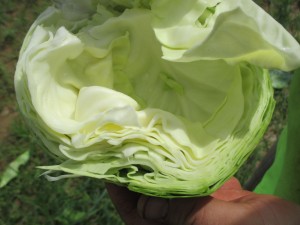Farmers in Meigs are suffering significant yield losses due to the extreme weather the area has experience this summer. We just finished one of the wettest Junes on record in Ohio. While obtaining a precipitation report for the months of May and June from the Racine Locks and Damn, Kim Johnson, NPR, pointed out that June of this year is the highest monthly total of precipitation that we have recorded for several years. The heavy rainfall, consistently wet weather, and cool temperatures are creating serious problems in the fields. A few major problems include (but not limited to): saturated and flooded fields, bacteria and fungus explosions, rapid weed growth, and leaching of field nutrients. Getting into the fields to combat these problems was extremely difficult due the to constant rain events and soil compactions issues.
These fruit s and vegetable producers have also been experiencing another problem in addition to field damage and diseases; unsellable produce. Producers have been undergoing short windows to harvest available produce. However, produce in the field has become water logged causing aesthetic problems (blemishes and crack) and transportation issues. Although some of the produce is perfectly edible, it is still being rejected due to aesthetic reasons. As a result, customers are reducing and cutting orders. For example, one farmer experienced a 1200 box (10 lbs/box) order cut from a major grocery store chain. This is only one example of such cuts.
All pictures were taken by OSU ANR educator Marcus McCartney on farms across the Racine locks and dam peninsula area to document the damage and diseases associated with the extreme wet weather events experienced during the months of June and July.
#1. Flooding
A. Pepper Field B. Tomato Field C. Watermelon field and D. Watermelon field after water receded
*NOTE: Peppers are growing in the Lakin loamy fine sand soil series. According the NRCS soil description, the natural drainage class is listed as “Excessively drained.” However, due to the amount rain and rainfall events, ponding and flooding occurred in highly drainable soils.
#2. Phytophthora blight in peppers
A) water-soaked patches (B) “Powdered sugar” Phytophthora spores (C) Infected row (D) large section of field infected
#3 Early Blight
A) concentric rings surrounded by a yellow halo (B) elongated spots with lighter-colored centers (C) Infected row
#4 White Mold explosion
A) Underneath watermelon (B) Cantaloupe (C) Cucumbers (D) White mold on weed in field
#5 Poor quality and rejected produce
A) Rejected tomato fruit due to cracking (B) Cabbage – loosely rolled heads, not tight leaf layers
The above information and pictures were generated into a report to depict the damage in Meigs County due to the excessive rainfall. This report was sent to FSA and then forwarded to Columbus. Also, the above pictures and information is just a sample from the report’s content.
















